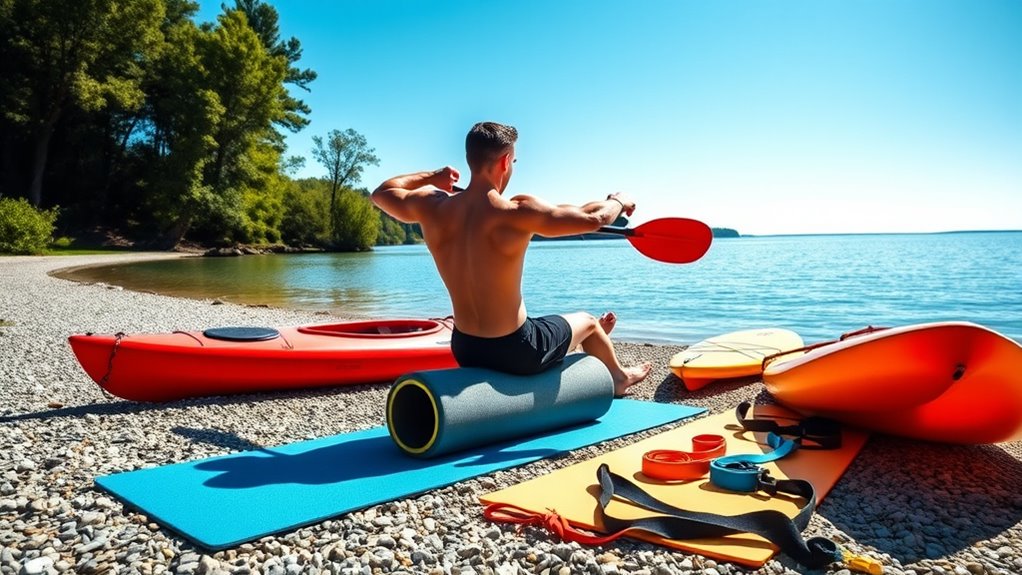A kayak and paddleboard conditioning guide helps you build strength, endurance, and balance to enjoy water activities safely. Focus on training core muscles, back, shoulders, and arms with resistance exercises and flexibility routines to prevent injuries. Incorporate cardio to boost stamina, and don’t forget warm-up and cool-down techniques for recovery. Creating a personalized plan guarantees progress and safety. Keep exploring for detailed tips that will help you stay prepared on the water.
Key Takeaways
- Incorporate strength, flexibility, and balance exercises targeting core, back, shoulders, and arms to improve paddling performance.
- Warm up dynamically before paddling and cool down with stretching and breathing techniques to prevent injuries and promote recovery.
- Engage in cardiovascular training like extended paddling, cycling, or swimming to build endurance and support longer water trips.
- Maintain proper equipment and follow environmental practices to ensure safety, sustainability, and ecological stewardship.
- Develop a personalized conditioning schedule that combines strength, cardio, flexibility, and recovery tailored to individual fitness levels.
Understanding the Importance of Conditioning for Water Sports
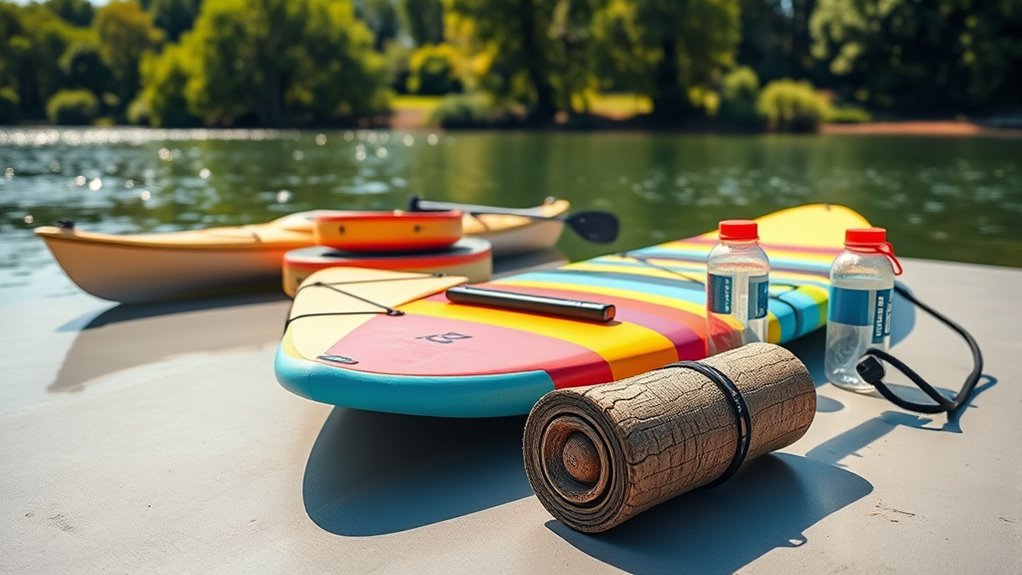
While enjoying kayaking and paddleboarding, your body needs to be prepared for the physical demands these activities require. Proper conditioning enhances your strength, endurance, and balance, making each outing safer and more enjoyable. Water safety is a top priority, and being physically prepared reduces the risk of fatigue that could lead to accidents. Conditioning also includes routine equipment maintenance, ensuring your gear functions properly and reduces unexpected issues on the water. When you’re in good shape, you can respond quickly to changing conditions, minimizing danger. Developing core strength and cardiovascular fitness helps you handle prolonged paddling sessions comfortably. Additionally, understanding industry trends can help you stay updated on the latest gear and safety practices, further enhancing your water adventures. Eye patch benefits highlight how proper care and routine can improve skin health and appearance, similar to how consistent conditioning benefits your water activities. Regular training exercises can also improve your overall mobility and reduce the likelihood of injuries. Ultimately, consistent conditioning prepares you mentally and physically, making your water adventures safer, more efficient, and more fun.
Key Muscle Groups for Kayaking and Paddleboarding

To excel at kayaking and paddleboarding, it’s essential to focus on strengthening the key muscle groups involved in these activities. Your core muscles, including your abdominals and obliques, provide stability and power during paddling. Your back muscles, especially the lats and rhomboids, drive the paddle stroke effectively. Your shoulders and arms, like your biceps and deltoids, enable you to reach and pull through the water. Ignoring muscle imbalances can lead to fatigue and injury, so balanced training is crucial. Incorporating stretching and flexibility exercises can further improve your range of motion and reduce injury risk. Staying properly hydrated is also vital, as dehydration can impair muscle function and recovery. Additionally, maintaining proper muscle balance helps prevent overuse injuries and enhances overall performance.
Warm-Up and Stretching Routines to Prepare Your Body

Before hitting the water, it is crucial to activate your muscles with dynamic stretching techniques. A full-body warm-up helps increase blood flow and prepares you for the physical demands ahead. These routines can boost your performance and reduce the risk of injury. Incorporating proper placement of your equipment during warm-up can further enhance your readiness and safety. Additionally, understanding tuning options for your kayak or paddleboard can optimize your performance and comfort on the water. Being aware of Gold IRA regulations can also help you make informed decisions about your investments and ensure compliance with IRS guidelines. It is also helpful to be familiar with store hours of local beauty retailers in case you need last-minute supplies before your outing.
Dynamic Stretching Techniques
Dynamic stretching is essential for effectively warming up your muscles and preparing your body for kayaking or paddleboarding. This technique involves moving parts of your body through a full range of motion, promoting muscle elongation and increasing blood flow. Unlike static stretching, dynamic stretching actively engages your muscles, which helps improve flexibility and joint mobility. Focus on controlled, purposeful movements such as arm circles, torso twists, leg swings, and shoulder rolls. These exercises target key muscle groups used in paddling, ensuring they’re ready for action. Incorporating dynamic stretching exercises into your warm-up routine can help reduce the risk of injury and improve your overall performance. When done properly, it primes your muscles for the physical demands of water sports, helping you stay comfortable and efficient on the water. Additionally, maintaining proper mindset and energy can significantly influence your overall water sport experience and performance. Preparing your muscles with proper conditioning techniques can also enhance endurance and strength over time. Engaging in proper warm-up routines can further optimize your readiness and help prevent muscle strains during your water activities.
Full-Body Warm-Up
A well-rounded full-body warm-up prepares all the muscles you’ll rely on during kayaking or paddleboarding. It increases blood flow, boosts flexibility, and reduces injury risk. Focus on dynamic movements like arm circles, torso twists, and leg swings to activate your core, shoulders, and legs. This helps you create a comfortable and cohesive bedroom environment for your water adventures. This primes your body for water safety and guarantees you’re alert while on the water. Proper gear selection, such as a life jacket and paddle, becomes more effective when your muscles are ready. Incorporate light cardio, like brisk walking or jumping jacks, to elevate your heart rate. Remember, a thorough warm-up helps you stay focused and perform better, whether you’re paddling solo or with a group. Engaging in performance tuning techniques can also enhance your endurance and strength for longer water excursions. Additionally, understanding the importance of contrast ratio can help you select equipment that optimizes visibility and safety during your water activities. Incorporating sound healing science principles such as focused breathing and mindful awareness during your warm-up can further improve concentration and mental readiness. Spend at least 10 minutes on this routine before hitting the water.
Strength Training Exercises for Enhanced Power

Building strength for kayaking and paddleboarding requires targeted exercises that boost your power and muscle control. Incorporate resistance band exercises to improve your rowing and paddling force, focusing on controlled pulls and holds to engage key muscle groups. Plyometric training is also essential; it enhances explosive power by developing fast-twitch muscle fibers. Try jump squats, box jumps, or medicine ball throws to increase your overall strength and reaction speed. These exercises help you generate more force during each stroke, making your movements more efficient and powerful. Understanding muscle fiber types can help tailor your training to maximize power development. Consistently integrating resistance band workouts and plyometrics into your routine will lead to noticeable improvements in your paddling strength, helping you handle challenging conditions and longer trips with greater ease and confidence. Incorporating proper training techniques also ensures safety and effectiveness in your workout regimen. Additionally, focusing on functional strength exercises can improve the transfer of your training gains to actual paddling situations. Knowing how to optimize your workout through muscle recruitment strategies can further enhance your performance.
Endurance Building Activities for Longer Trips
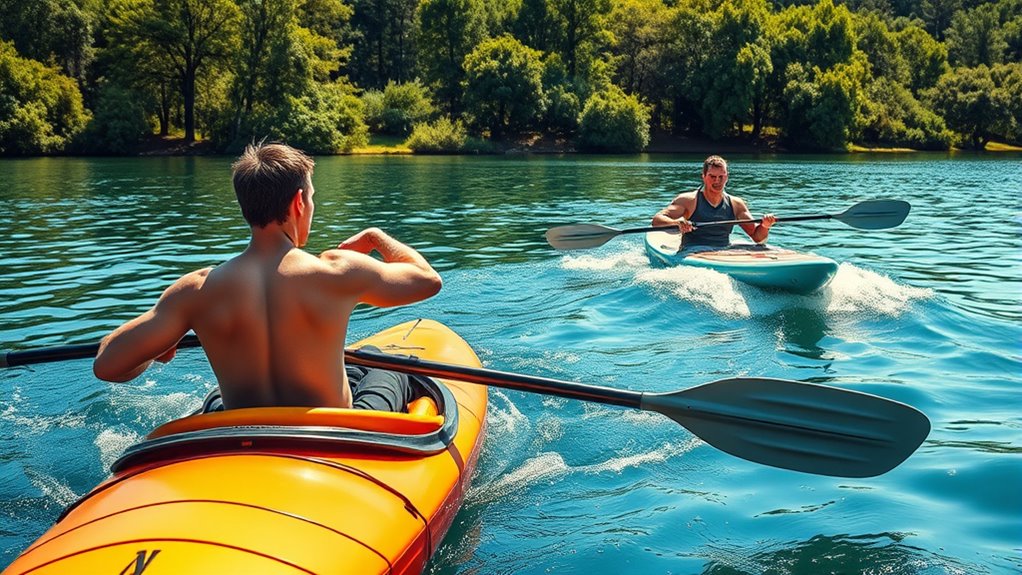
Enhancing your strength sets a solid foundation, but maintaining that power over long periods requires focusing on endurance. To build stamina, incorporate activities like extended paddling sessions, gradually increasing distance and duration. Focus on steady, controlled movements to boost your aerobic capacity, which helps you stay energized during longer trips. Pay attention to water safety by practicing techniques such as self-rescue and navigation, ensuring you’re prepared for unexpected situations. Watching for marine wildlife is also essential; staying alert keeps you safe and aware of your surroundings. Cross-training with low-impact cardio, like cycling or swimming, can further improve your endurance. Consistent practice not only enhances your physical capacity but also boosts confidence, enabling you to enjoy longer trips without fatigue or safety concerns.
Balance and Stability Drills to Improve Control
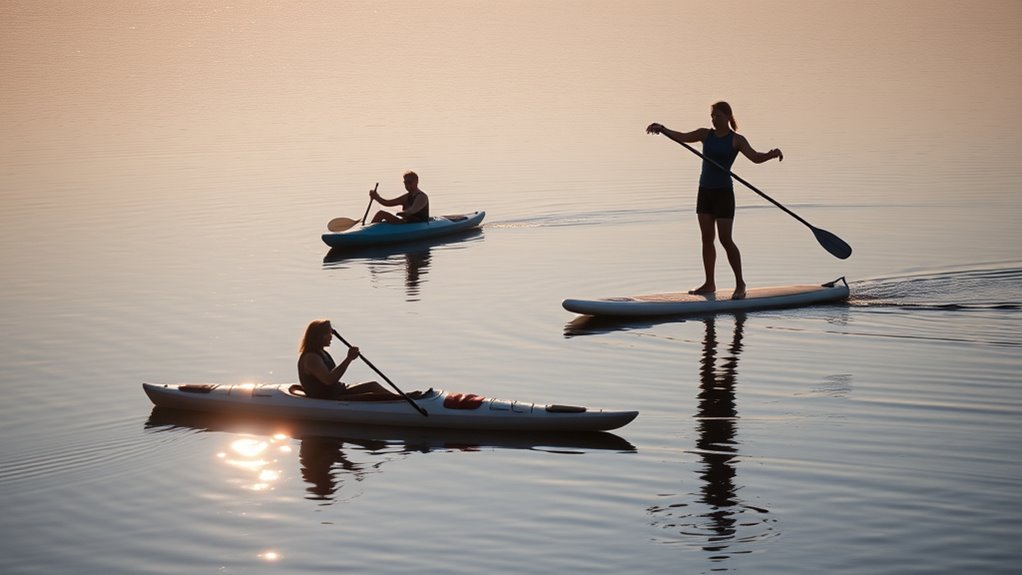
To improve your control on the water, focus on core engagement exercises that strengthen your stability. Incorporate single-leg balance drills to challenge your coordination and build confidence. These moves will help you stay steady during unpredictable conditions and enhance your overall performance.
Core Engagement Exercises
Focusing on core engagement exercises is essential for improving balance and stability on the water. You want to develop strong core activation so your muscles support controlled movements. Start with breathing techniques—deep, steady breaths—to help activate your core muscles and maintain focus during exercises. Incorporate planks, Russian twists, and seated torso rotations to build stability. Engage your abdominals and obliques intentionally, feeling the muscles work with each movement. Consistent practice of these exercises deepens your connection to your core, making balance easier when paddling or kayaking. Remember, proper breathing keeps your muscles oxygenated and sharpens your control. By strengthening your core through these targeted exercises, you’ll experience improved control and confidence on the water.
Single-Leg Balance Drills
Building a strong, stable core is key to maintaining control when paddling, and single-leg balance drills are excellent for developing this stability. These single-leg exercises enhance your balance training, helping you stay steady on your board or kayak. To perform them, stand on one foot, engage your core, and hold your position for 30 seconds or more. Keep your movements controlled and focus on maintaining proper posture. Switch sides and repeat, gradually increasing the duration as your stability improves. Incorporate these balance exercises into your routine regularly to boost your control and prevent falls. Single-leg balance drills challenge your stability, strengthen your muscles, and improve your overall coordination—making you a more confident paddler on the water.
Flexibility Practices to Prevent Injuries

Incorporating regular flexibility practices into your kayaking and paddleboarding routine can considerably reduce the risk of injuries. Stretching enhances your range of motion and prepares your muscles for physical activity. Focusing on breathing techniques and mental focus helps you relax and deepen stretches, improving effectiveness. Consistent flexibility routines prevent strains and overuse injuries by maintaining muscle elasticity. Incorporate dynamic stretches before paddling and static stretches afterward. Here’s a quick guide:
| Stretch Type | Key Benefit | Best Time |
|---|---|---|
| Dynamic Stretching | Warms up muscles, improves mobility | Pre-activity |
| Static Stretching | Increases flexibility, relaxes muscles | Post-activity |
| Breathing Techniques | Enhances relaxation, deepens stretches | During stretching |
| Mental Focus | Improves stretch quality, reduces tension | Throughout routine |
| Regular Practice | Builds resilience, prevents injury | Daily or weekly |
Cardiovascular Workouts for Overall Fitness

Adding cardiovascular workouts to your routine boosts your heart health and builds endurance, making paddling easier and more enjoyable. These exercises also help you burn calories effectively, supporting weight management. Incorporating regular cardio will enhance your overall fitness and prepare you for longer paddling sessions.
Boosts Heart Health
Engaging in regular cardiovascular workouts is one of the most effective ways to improve your heart health and overall fitness. Activities like kayaking and paddleboarding boost your cardiovascular system, enhancing blood flow and reducing heart disease risks. When practicing water safety and marine navigation, your pulse increases, strengthening your heart. These workouts also burn calories and improve lung capacity. To make it more relatable, here’s a quick comparison:
| Benefits of Cardio | How It Helps Your Heart |
|---|---|
| Increased stamina | Keeps your arteries clear |
| Better blood flow | Lowers blood pressure |
| Enhanced recovery | Reduces risk of cardiovascular issues |
Stay active, prioritize water safety, and enjoy the benefits of a healthy heart.
Enhances Endurance Levels
Regular cardiovascular workouts considerably boost your endurance, allowing you to stay active longer without fatigue. As you build stamina, you’ll handle longer kayaking or paddleboarding sessions more comfortably, improving your overall marine safety awareness. Enhanced endurance also helps you respond quickly in emergency situations, ensuring better decision-making on the water. When you engage in consistent cardio, you reduce your environmental impact by decreasing the need for motorized assistance or rescue efforts, promoting sustainable recreation. Furthermore, stronger cardiovascular health supports your body’s ability to recover faster after intense activity, keeping you prepared for future outings. Prioritizing endurance through cardio not only elevates your performance but also underscores your commitment to respecting marine safety guidelines and protecting the environment around you.
Burns Calories Effectively
Cardiovascular workouts are highly effective for burning calories and improving your overall fitness, making them an essential part of your conditioning routine. When engaging in activities like kayaking or paddleboarding, you’re not only boosting your heart health but also connecting with marine biology, understanding ecosystems, and the importance of clean water. These exercises help you burn calories efficiently, supporting weight management and endurance. Plus, they raise awareness about water pollution and its impact on aquatic life, encouraging eco-friendly habits. Incorporating consistent cardio sessions into your routine enhances stamina and promotes a healthier environment. As you paddle, you’re strengthening your body while fostering a deeper appreciation for the water’s delicate balance, making your fitness journey both effective and environmentally conscious.
Cool-Down and Recovery Strategies
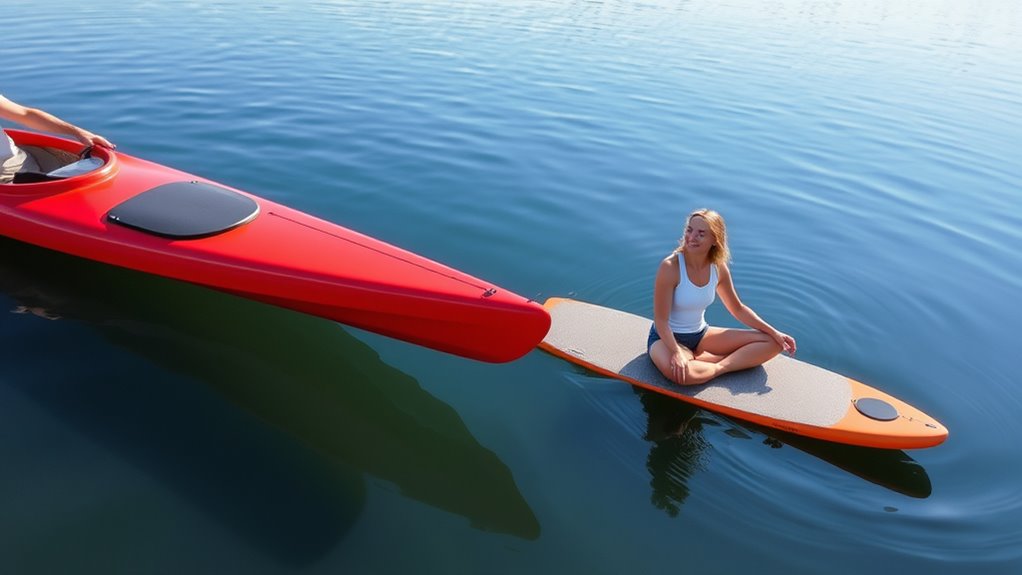
After a strenuous paddle session, prioritizing cool-down and recovery is essential to help your muscles relax and prevent soreness. Start with gentle stretching to release tension in your shoulders, back, and arms. Incorporate breathing techniques, such as deep, controlled inhales and slow exhales, to reduce your heart rate and promote relaxation. Focusing on your breath helps you stay mentally focused, easing any lingering fatigue or tension. Shift into light paddling or walking to gradually bring your body back to resting state. Hydrate well and consume nutrient-rich foods to support muscle repair. Remember, proper recovery isn’t just physical—it’s also mental. By staying present and mindful during cool-down, you prepare your body and mind for your next paddle adventure.
Creating a Personalized Conditioning Schedule
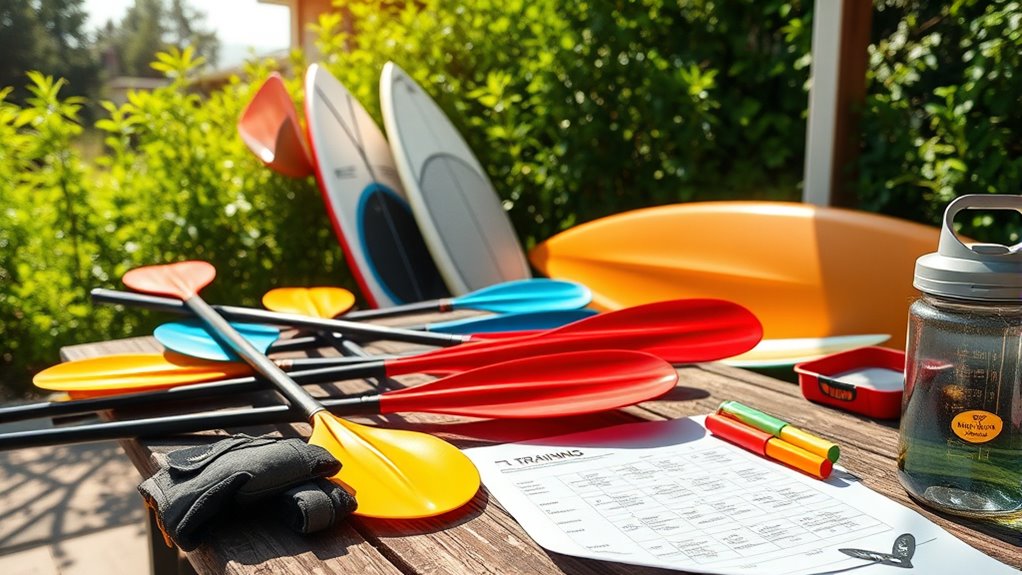
Creating a personalized conditioning schedule guarantees your paddling performance improves steadily while reducing the risk of injury. To do this effectively, consider your fitness level, paddling goals, and available time. Incorporate hydration strategies to stay energized and prevent fatigue during workouts. Prioritize equipment maintenance to ensure your gear is safe and functioning properly, preventing setbacks. Mix in strength training, cardiovascular workouts, and flexibility exercises tailored to your needs. Regularly review and adjust your schedule based on progress and any emerging limitations. Staying consistent and attentive to your body’s signals helps you avoid burnout and injury. A well-structured plan keeps you motivated and ensures each session builds toward your paddling success.
Frequently Asked Questions
How Often Should I Update My Conditioning Routine for Water Sports?
You should update your conditioning routine every few months to keep it effective. Incorporate seasonal adjustments, like shifting focus from endurance in summer to strength in winter. Also, include skill variation to prevent plateaus and stay motivated. Listen to your body and assess your progress regularly. If you notice a decline in performance or boredom, it’s time for an update. Regularly tweaking your routine guarantees continuous improvement and better water sport performance.
What Equipment Is Recommended for Strength Training at Home?
Think of your home gym as a personal training ground where strength is built brick by brick. You should start with resistance bands—they’re versatile and easy to store—and add dumbbells or a stability ball as you progress. Focus on exercises that target your core, arms, and back. Regularly update your routine every few months to challenge your muscles and keep your training fresh. This way, you’ll stay strong and ready for any water adventure.
How Do I Prevent Injuries During Intense Paddleboarding Sessions?
To prevent injuries during intense paddleboarding, focus on injury prevention strategies like incorporating proper warm-up routines before hitting the water. This prepares your muscles and joints, reducing strain. Pay attention to your form and avoid overexertion. Stay hydrated and take breaks when needed. Listening to your body helps prevent fatigue-related injuries, ensuring you enjoy paddleboarding safely and avoid unnecessary setbacks.
Are There Specific Dietary Tips to Enhance Water Sports Performance?
They say “fuel your fire,” and that’s true for water sports too. To boost your performance, focus on hydration strategies and nutrient timing. Drink water consistently before, during, and after your session, and eat balanced meals with carbs, protein, and healthy fats at ideal times. This combo keeps your energy steady and prevents fatigue, helping you stay sharp and agile on the water.
How Can I Track Progress Effectively Over Time?
To track your progress effectively, start with progress journaling. Record your workouts, how you feel, and any improvements you notice. Set performance benchmarks for key skills like paddling speed or endurance. Regularly review your journal to see trends and identify areas for improvement. This consistent tracking helps you stay motivated, adjust your training plan, and ultimately reach your water sports goals more efficiently.
Conclusion
By incorporating proper conditioning into your water sports routine, you’ll enhance performance and reduce injury risk. Did you know that athletes who follow targeted training programs recover 30% faster and perform 20% better? Consistent effort in strength, endurance, and flexibility exercises prepares you for longer, more enjoyable trips on the water. Stay dedicated to your conditioning plan, and you’ll see improvements in both your skills and overall fitness, making every paddle count.

